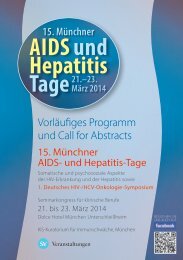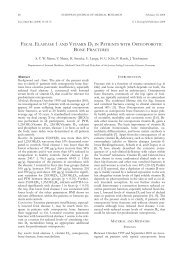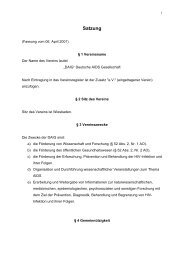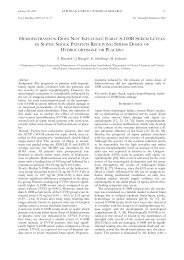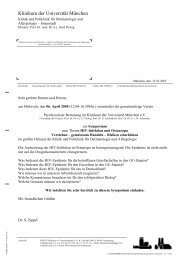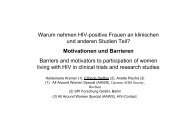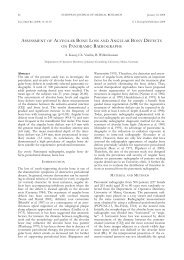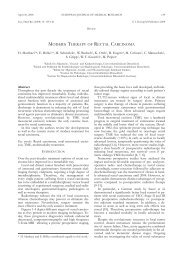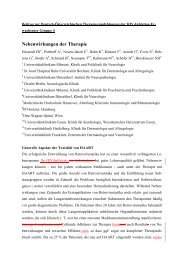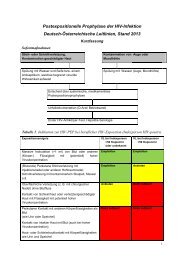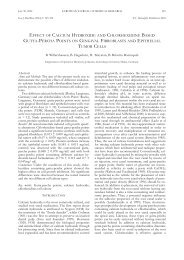European Journal of Medical Research - Deutsche AIDS ...
European Journal of Medical Research - Deutsche AIDS ...
European Journal of Medical Research - Deutsche AIDS ...
Create successful ePaper yourself
Turn your PDF publications into a flip-book with our unique Google optimized e-Paper software.
110 EUROPEAN JOURNAL OF MEDICAL RESEARCH<br />
June 27, 2007<br />
Methods: Over the time course, LPV-plasma-levels in consecutive<br />
patients with chronic liver disease (n=30) and consecutive<br />
patients without liver disease (n=38) were evaluated.<br />
LPV-plasma-levels were determined with a HPLC-based<br />
method. CD4-cell count and HI-viral load were also correlated<br />
with liver disease. Statistical analysis was done by multivariate<br />
analysis using the SPSS S<strong>of</strong>tware.<br />
Results: The LPV plasma-levels <strong>of</strong> n=450 samples from 30<br />
patients with liver disease (Hepatitis B: n=17, Hepatitis C:<br />
n=16, Alcoholic liver disease: n=7) were determined over<br />
18.7±16,3 months (1 - 48.5 months). A median <strong>of</strong> 10 samples<br />
per patient was eligible (2 - 50 samples). All patients received<br />
400 mg LPV bid with various nuke-back-bones. There were<br />
no significant differences according to liver disease in LPVplasma<br />
levels (mean Ctrough without: 5.917±4.811 ng/ml,<br />
mean Ctrough with liver-disease: 6.564±4.517 ng/ml, p ><br />
0.05). The intraindividual and interindividual variation <strong>of</strong><br />
LPV-plasma levels, CD-4 increase, and HI-virus suppression<br />
in patients with and without liver disease were comparable.<br />
Conclusion: In this clinical setting no differences in LPVplasma<br />
levels between patients with and without chronic liver<br />
disease could be demonstrated. LPV-therapy in patients with<br />
chronic liver disease is safe. TDM is a helpful tool in patients<br />
with impaired liver function for dose adjustment.<br />
D.78 (Poster)<br />
A weight adapted nelfinavir (NFV) containing<br />
ART may decrease pill-burden<br />
Winzer R. 1 , Hillenbrand H. 2 , Galle P.R. 1 , Löhr H. 3 ,<br />
Böcher W. 1<br />
1 I. Medizinische Klinik der Universität Mainz, Mainz,<br />
Germany, 2 Schwerpunktpraxis, Berlin, Germany, 3 Praxis für<br />
Gastroenterologie, Wiesbaden, Germany<br />
Background: ART consisting <strong>of</strong> 2 NRTI + PI or NNRTI is<br />
standard today. Most antiretroviral drugs are dosed without<br />
consideration <strong>of</strong> individual patients weight. However, weight<br />
based dosing might reduce pill burden and increase treatment<br />
adherence, an important factor <strong>of</strong> treatment response.Thus,<br />
we compared a weight adapted NFV containing therapy<br />
(25mg/kg/d) with one with standard dosage (2500mg/d) in respect<br />
to pharmacokinetic, virological and immunological parameters.<br />
Method: In this prospective, open-label monocenter trial over<br />
48 weeks, patients on stable NFV containing ART<br />
(>3months) were sex and weight-related randomised either to<br />
a weight adapted (group A: 25mg/kg/d, n=14) or standard<br />
dosage (group B: 2500mg/d, n=14) NFV containing ART in<br />
combination with 2 NRTIs. Pharmacokinetic examinations<br />
were carried out at baseline, week 4 and week 12, virological<br />
and immunological parameters were done every 3 months.<br />
Data were analysed with Kruskal-Wallis test.<br />
Results: In total, 28 patients (m/f: 17/11; average age:<br />
43±9years) were randomised; 23 patients reached week 48<br />
(one screening-failure, one lost to-follow up at week 24, one<br />
virological therapy failure at week 36, two study unrelated<br />
deaths after week 36). Even though both groups were well<br />
matched regarding their body-mass-index (A: 22.83 ±<br />
4.09kg/m 2 , B: 23.95 ± 3.49kg/m 2 ) there were no significant<br />
differences concerning most pharmacokinetic parameters<br />
(Ctroughbaseline: 1540./.820ng/ml, p1log-raise)<br />
week 48, B: one virological failure week 36) and<br />
immunological treatment responses (CD4-increaseweek48:<br />
30./.56cells/�; p = 1.0) did not differ between both groups, although<br />
the administered NFV dosages and pill burden were<br />
significantly reduced in treatment group A (A: 24.05 ±<br />
2.12mg/kg/d, B: 36.16 ± 8.58mg/kg/d; p = 0.001).<br />
Summary: In this study, there were no significant differences<br />
in the treatment response to weight adapted (25mg/kg/d) or<br />
standard dosage (2500mg/d) NFV containing antiretroviral<br />
therapy. Thus, a reduction <strong>of</strong> pill burden and treatment adherence<br />
seems reasonable under the conditions <strong>of</strong> therapeutical<br />
drug monitoring.<br />
D.79 (Poster)<br />
Anticonvulsants in patients on antiretroviral<br />
therapy: Case report and literature review<br />
Thaler J. 1 , Emmelkamp J. 1 , Bode J. 1 , Oette M. 1 ,<br />
Strzelczyk A. 2<br />
1 Universitätsklinikum Düsseldorf, Hepatologie,<br />
Gastroenterologie und Infektiologie, Düsseldorf, Germany,<br />
2 Universität Marburg, Neurologie, Marburg, Germany<br />
Objective: To give an overview on published literature on the<br />
use <strong>of</strong> anticonvulsants in patients on antiretroviral therapy and<br />
to provide recommendations on their concurrent use.<br />
Background: In patients with HIV infection seizures are a<br />
relatively common occurrence. Seizures may be a result <strong>of</strong><br />
HIV infection <strong>of</strong> the CNS, a manifestation <strong>of</strong> an opportunistic<br />
infection or a result <strong>of</strong> mass lesions. As they are likely to recur<br />
in HIV-seropositive patients anticonvulsive treatment is<br />
generally advisable for a first seizure without a recognisable<br />
and reversible cause.<br />
For the clinicians caring for HIV-seropositive patients anticonvulsants<br />
and antiretrovirals impose therapeutic dilemmas<br />
as they may interact through multiple mechanisms including<br />
enhanced or inhibited liver metabolism, competition for protein<br />
binding and increased viral replication.<br />
Case report: A 40 year-old patient with HIV Infection presented<br />
with a first seizure due to a primary CNS lymphoma.<br />
As the patient was under HAART, carbamazepine could not<br />
be adminstered because <strong>of</strong> significant pharmacological interactions.<br />
As with use <strong>of</strong> valproic acid a seizure control could<br />
not be obtained, levetiracetam was introduced because <strong>of</strong> little<br />
or no known interaction with HAART but had to be removed<br />
because <strong>of</strong> a disabling tremor. Finally the introduction <strong>of</strong> lamotrigine<br />
was well tolerated and lead to seizure control.<br />
Methods: A systematic literature review was performed to<br />
identify literature on the concurrent use <strong>of</strong> anticonvulsants<br />
and antiretrovirals. Using a standardized assessment form, information<br />
was extracted from each publication and systematically<br />
reported.<br />
Results and conclusions: There is only limited data available<br />
regarding interactions for the use <strong>of</strong> anticonvulsants in patients<br />
on antiretroviral therapy resulting in an urgent need for<br />
controlled trials examining pharmacokinetic and pharmacodynamic<br />
interactions between anticonvulsants and antiretrovirals.<br />
Valproic acid and newer anticonvulsants including<br />
gabapentine, lamotrigine and levetiracetam may be considered<br />
<strong>of</strong> reasonable choice compared to first-generation agents.<br />
However, close monitoring for anticonvulsant-antiretroviral<br />
interactions is advisable because <strong>of</strong> the potential for toxicity,<br />
poor seizure control and incomplete viral suppression.



